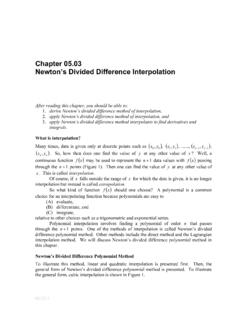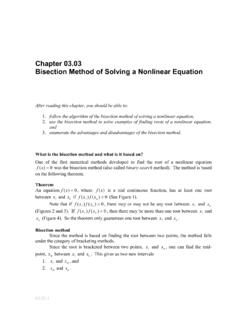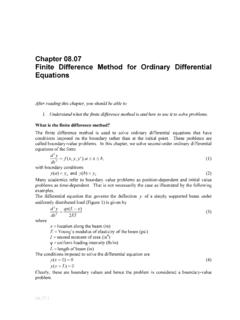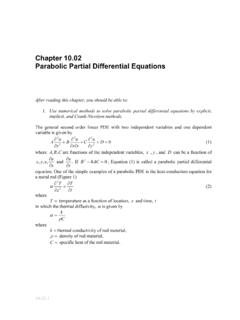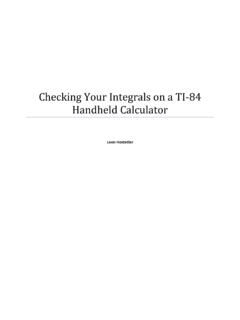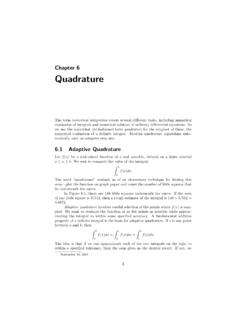Transcription of simpson's 1/3 rule - MATH FOR COLLEGE
1 Chapter Simpson s 1/3 Rule of Integration After reading this chapter, you should be able to 1. derive the formula for Simpson s 1/3 rule of integration, 2. use Simpson s 1/3 rule it to solve integrals, 3. develop the formula for multiple-segment Simpson s 1/3 rule of integration, 4. use multiple-segment Simpson s 1/3 rule of integration to solve integrals, and 5. derive the true error formula for multiple-segment Simpson s 1/3 rule. What is integration? Integration is the process of measuring the area under a function plotted on a graph. Why would we want to integrate a function? Among the most common examples are finding the velocity of a body from an acceleration function, and displacement of a body from a velocity function.
2 Throughout many engineering fields, there are (what sometimes seems like) countless applications for integral calculus. You can read about some of these applications in Chapters Sometimes, the evaluation of expressions involving these integrals can become daunting, if not indeterminate. For this reason, a wide variety of numerical methods has been developed to simplify the integral. Here, we will discuss Simpson s 1/3 rule of integral approximation, which improves upon the accuracy of the trapezoidal rule. Here, we will discuss the Simpson s 1/3 rule of approximating integrals of the form ( ) =badxxfI where )(xf is called the integrand, =a lower limit of integration =b upper limit of integration Simpson s 1/3 Rule The trapezoidal rule was based on approximating the integrand by a first order polynomial, and then integrating the polynomial over interval of integration.
3 Simpson s 1/3 rule is an Chapter extension of Trapezoidal rule where the integrand is approximated by a second order polynomial. Figure 1 Integration of a function Method 1: Hence =babadxxfdxxfI)()(2 where )(2xf is a second order polynomial given by 22102)(xaxaaxf++=. Choose )),(,(afa,2,2 ++bafba and ))(,(bfb as the three points of the function to evaluate ,0a1a and 2a. 22102)()(aaaaaafaf++== 221022222 ++ ++= += +baabaaabafbaf 22102)()(babaabfbf++== Solving the above three equations for unknowns, ,0a 1a and 2a give 222202)()(24)()(babaafbaabfbaabfbabfbfaa + ++ + += 2212)(24)(3)(324)(bababbfbabfabfbafbaafa afa+ + + ++ + = Simpson s 1/3 Rule of Integration 2222)(22)(2bababfbafafa+ + + = Then badxxfI)(2 () ++=badxxaxaa2210 baxaxaxa ++=3232210 32)(3322210abaabaaba + + = Substituting values of ,0a 1a and 2a give + ++ = )(24)(6)
4 (2bfbafafabdxxfba Since for Simpson 1/3 rule, the interval [ ]ba, is broken into 2 segments, the segment width 2abh = Hence the Simpson s 1/3 rule is given by + ++ )(24)(3)(bfbafafhdxxfba Since the above form has 1/3 in its formula, it is called Simpson s 1/3 rule. Method 2: Simpson s 1/3 rule can also be derived by approximating )(xf by a second order polynomial using Newton s divided difference polynomial as + + +=2)()()(2102baxaxbaxbbxf where )(0afb= abaafbafb + +=2)(21 Chapter ababaafbafbabbafbfb + + + + =2)(222)(2 Integrating Newton s divided difference polynomial gives us babadxxfdxxf)()(2 + + +=badxbaxaxbaxbb2)()(210 baxbaaxbaxbaxxbxb +++ + +=2)(4)3(32232210 ++ + + + =2))((4))(3(3 )(2)
5 (223322210abbaaabbaabbabaabbabb Substituting values of ,0b ,1b and 2b into this equation yields the same result as before + ++ )(24)(6)(bfbafafabdxxfba + ++=)(24)(3bfbafafh Method 3: One could even use the Lagrange polynomial to derive Simpson s formula. Notice any method of three-point quadratic interpolation can be used to accomplish this task. In this case, the interpolating function becomes )(2)(2)(222))(()()(2)(2)(2bfbababbaxaxba fbbaababxaxafbabaabxbaxxf + + + + + + + + + = Integrating this function gets Simpson s 1/3 Rule of Integration bababfbababxbaaxbaxbafbbaabaabxxbaxafbab aaxbabxbaxdxxf + +++ + + + +++ + + +++ = )(2)(2)(4)3(32222)(3)()(22)(4)3(3)(23232 32 )(2)(2))((4))(3(3222)(2))((3)()(22))((4) )
6 (3(3223322332233bfbabababbaaabbaabbafbba abaabababbaabafbabaaabbababbaab + ++ + + + + + + + + + ++ + = Believe it or not, simplifying and factoring this large expression yields you the same result as before + ++ )(24)(6)(bfbafafabdxxfba + ++=)(24)(3bfbafafh. Method 4: Simpson s 1/3 rule can also be derived by the method of coefficients. Assume )(2)()(321bfcbafcafcdxxfba+ ++ Let the right-hand side be an exact expression for the integrals ,1 badx, baxdx and badxx2. This implies that the right hand side will be exact expressions for integrals of any linear combination of the three integrals f or a general second order polynomial. Now 3211cccabdxba++= = Chapter bcbacacabxdxba3212222+++= = 23222133223bcbacacabdxxba+ ++= = Solving the above three equations for ,0c 1c and 2c give 61abc = 3)(22abc = 63abc = This gives )(623)(2)(6)( bfabbafabafabdxxfba + + + + ++ =)(24)(6 bfbafafab + ++=)(24)(3bfbafafh The integral from the first method ++ babadxxaxaadxxf)( )( 2210 can be viewed as the area under the second order polynomial, while the equation from Method 4 )(623)(2)(6)( bfabbafabafabdxxfba + + + can be viewed as the sum of the areas of three rectangles.))
7 Example 1 The distance covered by a rocket in meters from 8=ts to 30=ts is given by = a) Use Simpson s 1/3 rule to find the approximate value of x. b) Find the true error, tE. c) Find the absolute relative true error, t . Simpson s 1/3 Rule of Integration Solution a) + ++ )(24)(6bfbafafabx 8=a 30=b 192=+ba )( = )8( )8(2100140000140000ln2000)8(= = )30( )30(2100140000140000ln2000)30(= = )19( )19(2100140000140000ln2000)19(= = + ++ )(24)(6bfbafafabx [])30()19(4)8(6830fff++ = [] + += = m b) The exact value of the above integral is = = m So the true error is ValueeApproximatValueTrueEt = = = c)
8 The absolute relative true error is 100 Value TrueError True = t = Chapter % Multiple-segment Simpson s 1/3 Rule Just like in multiple-segment trapezoidal rule, one can subdivide the interval [ ]ba, into n segments and apply Simpson s 1/3 rule repeatedly over every two segments. Note that n needs to be even. Divide interval [ ]ba, into n equal segments, so that the segment width is given by nabh =. Now =nxxbadxxfdxxf0)()( where ax=0 bxn= ++++=nnnnxxxxxxxxbadxxfdxxfdxxfdxxfdxxf2 244220)()(..)()()( Apply Simpson s 1/3rd Rule over each interval, ..6)()(4)()(6)()(4)()()(4322421002+ ++ + ++ xfxfxfxxxfxfxfxxdxxfba ++ + ++ + 6)()(4)()(6)()(4)()(12223442nnnnnnnnnnxf xfxfxxxfxfxfxx Since hxxii22= ,,4,2= then.
9 6)()(4)(26)()(4)(2)(432210+ +++ ++ xfxfxfhxfxfxfhdxxfba +++ +++ 6)()(4)(26)()(4)(212234nnnnnnxfxfxfhxfxf xfh {} {}[])()(..)()(2)(..)()(4)(32421310nnnxfx fxfxfxfxfxfxfh+++++++++= Simpson s 1/3 Rule of Integration +++= == ==)()(2)(4)(322110nneveniiinoddiiixfxfxf xfh +++ == ==)()(2)(4)(3)(22110nneveniiinoddiiibaxf xfxfxfnabdxxf Example 2 Use 4-segment Simpson s 1/3 rule to approximate the distance covered by a rocket in meters from 8=ts to 30=ts as given by = a) Use four segment Simpson s 1/3rd Rule to estimate x. b) Find the true error, tE f or part (a). c) Find the absolute relative true error, t for part (a).
10 Solution: a) Using n segment Simpson s 1/3 rule, +++ == ==)()(2)(4)(322110nneveniiinoddiiitftftf tfnabx 4=n 8=a 30=b nabh = 4830 = )( = So )8()(0ftf= )8( )8(2100140000140000ln2000)8(= = ) () ()(1fftf=+= Chapter ) ( ) (2100140000140000ln2000) (= = )19() ()(2fftf=+= )19( )19(2100140000140000ln2000)19(= = ) () ()(3fftf=+= ) ( ) (2100140000140000ln2000) (= = )30()()(4ftftfn== )30( )30(2100140000140000ln2000)30(= = +++ = == ==)()(2)(4)(322110nneveniiinoddiiitftftf tfnabx +++ = ====2231)30()(2)(4)8()4(3830eveniiioddii iftftff [])30()(2)(4)(4)


